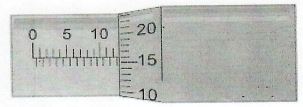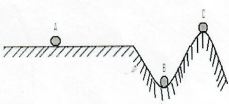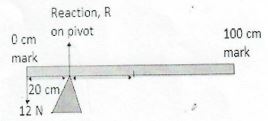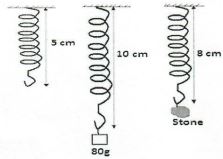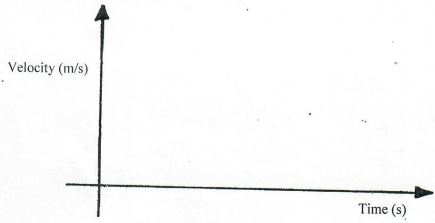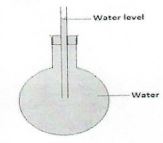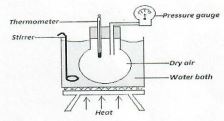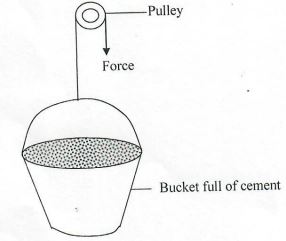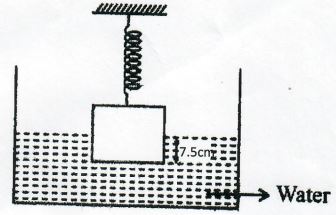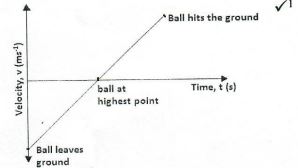INSTRUCTIONS.
- The paper consists of two sections, section A and B.
- Answer all the questions in the two sections in the spaces proved after each question
- All working must be clearly shown
- Electronic calculators and Mathematical tables may be used.
- All numerical answers should be expressed in the decimal notations
SECTION A (25MKS)
- Figure 1 below shows the scale of micrometer screw gauge after being used to measure the diameter of a marble whose volume is
1047. 816 mm2.
Find the zero error of the micrometer screw gauge used (3mks) - Name one state of matter in which Brownian motion occurs. (1mk)
- Describe the state of equilibrium of the ball in each position (3mks)
A
B
C - A diver working under water is 15 m below the surface of the sea. Calculate the pressure due to water experienced by the diver (take g=10N/kg) and density of sea water to be equal to 1.03g/cm3. (2mks)
- The figure below shows two glass tubes of different diameter dipped in water.
Explain why h2 is greater than h1 (2mks) - A uniform meter rule is balanced at 20cm mark when a load of 12N is hung at the zero mark.
Calculate the Reaction force R acting at the pivot (3mks) - The figure below shows a spring when unloaded, when supporting a mass of 80g and when supporting a stone. Study the diagrams and use them to determine the mass of the stone. (3mks)
- Define Heat (1mk)
-
- State Bernoulli's principle (1mk)
- The figure below shows a tube of varying cross-section area. V1, V2, V3 and V4 represent the speed of water as it flows steadily through the sections of the tube (1mk)
Arrange the speeds V1, V2, V3 and V4 in decreasing order starting with the highest
- Consider a ball thrown vertically upwards from the ground. Sketch the velocity-time graph of the ball from when it leaves the ground until it hits the ground again. (1mk)
- State one difference between Evaporation and Boiling (1mk)
- A hammer of mass 800 g produces a force of 400 N when it strikes the head of a nail. Describe how it is possible for the hammer to drives the nail into a piece of wood, yet a weight of 400 N resting on the head of the nail would not. (2mks)
- Figure below shows a flask filled with water. The flask is fitted with a cork through which a tube is inserted. When the flask is cooled the water level rises slightly and then falls steadily. Explain. (1mk)
SECTION B (55 MKS)
-
- State pressure law. (1mk)
- The set up below shows an arrangement used to determine the relationship between temperature and pressure of a gas at constant volume.
State the measurements that need to be taken in this experiment (2mks) - Describe how the set-up can be used to verify pressure law (3mks)
- A gas in container has pressure of 3.0 x 105 Pa when the temperature is 20°C. Determine the pressure of the gas when the temperature lowered to −5°C (assume there is no change in volume) (3mks)
-
- An astronaut in orbit round the earth may feel weightless even when the earth's gravitational field still acts on him. Explain (2 marks)
- Distinguish between angular velocity and linear velocity (1 mark)
- a stone is whirled with uniform speed in a horizontal circle of radius 15 cm. it takes the stone 10 seconds to describe an arc of length 4cm. calculate
- Angular velocity (3 marks)
- Linear velocity of the stone (2 marks)
- Periodic time (2 mks)
- Name any two factors affecting centripetal Force. (2mks)
- A worker on a building site raises a bucket full of cement at a slow steady speed using the pulley as shown below.
The weight of the bucket and cement is 200N. The force F exerted by the worker is 210N- State why F is bigger than the weight of the bucket and cement. (1 mark)
- The bucket is raised through a height by 4m. Determine the distance through which the worker pulls the rope. (1 mark)
- How much work is done on the bucket and cement? (3 marks)
- State the kind of energy gained by the bucket. (1 mark)
- Determine the total work done be the worker. (3 marks)
- Calculate the efficiency of the machine used by the water. (3 marks)
-
- What is meant by specific latent heat of fusion of a substance? (1mk)
- In an experiment to determine the specific latent heat of vaporization of water, steam at 100°C was passed into water contained in a well-lagged copper calorimeter. The following measurements were made:
- Mass of calorimeter = 60g
- mass of water + calorimeter = 145g
- Final mass of calorimeter + water + condensed steam Final temperature of the mixture = 48°C
[Specific heat capacity of water = 4200JKg−1k− and specific heat capacity of copper = 390JKg−1k−1]
Determine the;- Mass of condensed steam. (1mk)
- The heat gained by the water and calorimeter if the initial temperature of the calorimeterandwateris 20°C. (3mks)
- Given that Lv is the specific latent heat of vaporization of steam, write an expression for the heat given out by steam. (3mks)
- Determine the value of Lv above (2mks)
-
- State the law of floatation (1 mark)
- The figure (5) below shows a metallic rod of length 10cm and uniform cross- sectional area 4cm2 suspended from spring balance with 7.5 cm of its length immersed in water. The density of the material is 1.5g/cm3.The density of water is 1 g/cm3.
Determine:- The mass of the rod (3mks)
- The upthrust acting on the rod (3mks)
- The reading of the spring balance (2mks)
- The reading of the spring balance when the rod is wholly immersed in water (3mks)
MARKING SCHEME
- Volume of spherical ball = 4/3πr3 = 1047.816 mm3 ✓1
r3 = 3/4 x 7/22 x 1047.816
r = 6.30 mm
d = 6.30mm x 2 =12.60mm
Micrometer screw gauge reading = 12.50 mm + 0.16 mm = 12.66 mm
Erred value -Zero Error = Actual Value
Zero Error = Erred value - Actual Value = 12.66 mm - 12.60mm = + 0.06mm✔1 -
- Gas ✓1
- Liquids
-
- - Neutral
- - B-Stable
- - Unstable
-
P = hpg 1
= 15 m x 1030 kg/m3 x 10 N/kg
= 154500 N/m2✓1 -
- Adhesive force in narrow tube is greater than adhesive force in wider tube. ✓1
- Volume of water in both tubes is the same hence the column of water in narrow tube h2 is greater. ✔
- At equilibrium, Sum C.M = Sum of A.C.M✓1
W x 0.3 m = 1.2 N x 0.2 m
0.3 W = 0.24
∴ W = 0.24
0.3 = 0.8 N✓1
Reaction force R = total downwaed forces = total up ward forces
R = 12 + W
R = 12 + 0.8
= 12.8 N✓1 -
k = F/e = mg/e
k = (80 x 10−3 x 10)N = 16Nm−1
(10 − 5)×10-2m
F = Wstone = ke
Wstone = 16N/m x 3 x 10−2 = 0.48N
m = w/g = 0.48N = 0.048kg
10Nkg−1 - Heat is a form of energy which flows from a point of higher temperature to another point of low temperature. ✔
-
- Provided the fluid is non- viscous, incompressible and has a streamline flow, the sum of pressure, kinetic energy per unit volume and potential energy per unit volume is a constant. ✓
- V2 > V4 > V1 > V3√
-
- Difference between Evaporation and Boiling
Evaporation Boiling It takes place at all temperatures. It takes place at fixed temperature. It takes place on the liquid surface only. It takes place throughout the liquid. Decreasing atmospheric pressure increases the rate of evaporation. Decreasing atmospheric pressure lowers the boiling point. ✔1 - On striking the nail, the hammer impacts the impulsive force to the nail and the nail gains large momentum. 'This result into increase in the velocity and kinetic energy that makes the nail moves in the wood. ✔1
- Glass flask contracts first reducing in volume leading to water raising in the tube. Water then contracts reducing its level in the tube
SECTION B
-
- The pressure of a fixed mass of a gas is directly proportional to the absolute (kelvin) temperature at a constant volume. ✓1
-
- Temperature ✓1
- Pressure
-
- The initial temperature and pressure reading are taken and recorded✓
- The water bath is heated gently and some more pairs of pressure and temperature readings are taken and recorded at suitable temperature intervals and a graph of pressure against temperature is plotted. ✓
- It is a straight line with positive gradient which shows that the pressure is directly proportional to absolute temperature. ✔l
T1 = 20°C = 293 K, T2 = −5 °C = 268 K,
P1 = 3.0 x 105 Pa, P2 =?
P1 = P2
T1 T2
3.0 x 105 Pa = P2 =
293 K 268 K
P2 = 3.0 x 105 Pa x 268 K = 2.744 x 105 Pav1
293
-
- Gravitationalforce of attraction between the Astronaut and earth provides centripetal force. For the astronaut to move round orbit then gravitational force must be equal to centripetal force. ✔1
- Angular velocity is the rate of change of angular displacement while linear velocity is the rate of displacement. ✔1
-
- ω = Aθ/ At
= 0.02667/10
= 0.002667rad/sec - v = r ω
= 0.15 X 0.002667
= 0.0004 m/s - T = 2л/ω
= 2л/0.002667
= 2355.9 sec✓1 1
- ω = Aθ/ At
-
- Mass of the object
- Velocity of the object
- Radius of the circle
-
- Extra force was to overcome the weight of the body and friction1
- Since V.R is 1, the worker pulls the ropes through 4 m ✓1
- Work = Force x distance ✓
= 200 x 4✓1 = 800J1 (Deny 1⁄2 marks for missing units in F.A) - Potential Energy ✓1
- Total Work = Effort x distance ✓1
= 210 x 4 = 840 J✓1 - η = Work output x 100 ✓1
Work input
800 x 100 = 95% ✓1
840
-
- The amount of heat energy required to change a unit mass of solid to liquid at constant temperature. ✓
-
- mass of condensed steam.
Mass of steam = 156 − 145
= 11 g -
Heat gained by water + heat gained by calorimeter1 = 0.085 X 4200 (48 − 20) + 0.06 X 390(48 − 20)
= 10,651.2 J✓1 - Heat lost by steam = Heat lost by condensing steam + heat lost by condensed steam
= 0.011 X Lv + 0.011 X 4200 X (100 − 48) ✓
= 0.011Lv + 2,402.4✓ - Heat lost by steam + heat lost by condensed water = heat gained by water + heat gained by calorimeter
0.011 XLv + 0.011 X 4200 X (100 – 48) = 0.085 X 4200 (48 − 20) + 0.06 X 390(48 − 20) ✓
LV = 749,890.9091JKg−1
- mass of condensed steam.
-
- A floating object displaces its own weight of the fluid of the fluid in which it floats
-
- p = m/v or M = ρv ✓1
M = 1.5 x 4 x 10
M = 60g or 0.06 kg✔1 - U = ρvg✓
U = 1000 × 4 x 7.5 x 10
1000000 = 0.3N ✓1 - W object - U1
0.6 − 0.3
0.3 N✓1 - U = ρvg✓1
= 1000 × 40 x 10
100000
= 0.4N✓
W − U
0.6 − 0.4
0.2N 1
- p = m/v or M = ρv ✓1
Download Physics Paper 1 Questions and Answers - Samia Joint Mock Examination 2023.
Tap Here to Download for 50/-
Get on WhatsApp for 50/-
Why download?
- ✔ To read offline at any time.
- ✔ To Print at your convenience
- ✔ Share Easily with Friends / Students

